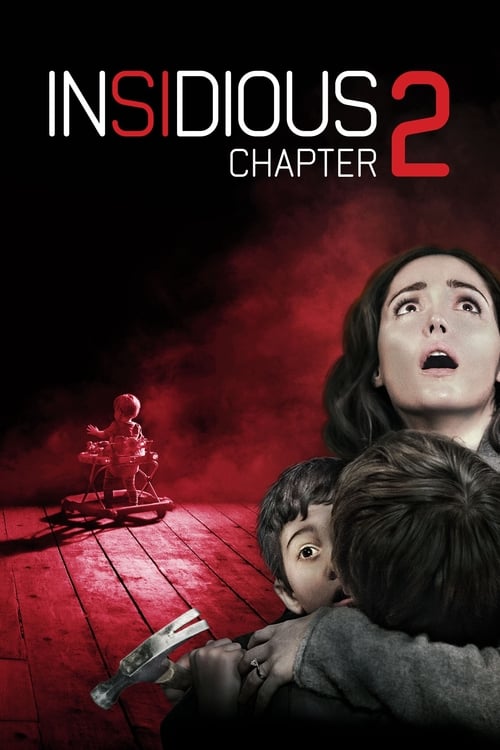Insidious: Chapter 2 – Film Review
Published July 6, 2023

Soon after their showdown with evil spirits that possessed their son, the Lamberts, Renai and Josh, are ready for their lives to return to normal. However, something still is seriously off, especially with Josh, who — unbeknown to Renai — is possessed too. In order to free Josh’s soul and finally defeat the malevolent forces around them, Lorraine Lambert and her ghost-hunting friends investigate the past to save her family’s future.
James Wan‘s Insidious: Chapter 2 is a perplexing blend of horror and psychological thriller that attempts to build upon the foundations laid by its predecessor. While the film succeeds in delivering some chilling moments and a few unexpected twists, it ultimately falls short of reaching the same level of intrigue and originality as its predecessor.
Picking up immediately after the events of the first film, Insidious: Chapter 2 continues the story of the Lambert family as they struggle to uncover the dark secrets that have plagued them. Josh (played by Patrick Wilson) and Renai (played by Rose Byrne) are still reeling from their previous encounters with the supernatural, and as they try to resume their normal lives, they quickly realize that the forces they thought they had left behind are far from finished with them.
One of the strengths of the film lies in its ability to create a genuinely eerie atmosphere. James Wan, known for his skill in crafting tension and suspense, employs a variety of clever techniques to keep the audience on edge. From the clever use of shadows to the haunting score, every element works together to build a sense of dread and unease. The film’s setting, a seemingly normal suburban home, becomes a character in itself, with the walls seemingly holding hidden secrets and the creaking floors intensifying the sense of impending doom.
The performances in Insidious: Chapter 2 are solid overall, with Patrick Wilson delivering a particularly convincing portrayal of a man tormented by his own demons. Rose Byrne brings a sense of vulnerability to her role as Renai, effectively conveying the character’s fear and desperation. The chemistry between the two actors adds depth to their on-screen relationship, making their plight more relatable and emotionally resonant.
Where the film falls short, however, is in its narrative execution. While the first film took a unique approach to the haunted house genre, blending it with elements of astral projection and otherworldly dimensions, the sequel struggles to find its footing. The storyline becomes convoluted and confusing at times, with multiple plot threads that don’t always come together in a satisfying manner. The attempt to expand upon the mythology of the first film feels forced and ends up detracting from the overall impact.
Additionally, the pacing of Insidious: Chapter 2 feels uneven. The film starts off strong, with a few genuinely terrifying sequences that grip the audience from the beginning. However, as the story progresses, it loses some of its momentum. The middle act becomes bogged down by unnecessary exposition and repetitive scares that fail to have the same impact as earlier moments. The climax, while attempting to tie up loose ends, feels rushed and somewhat anticlimactic, leaving the audience with more questions than answers.
Despite its narrative flaws, the film does have its fair share of effective scares. James Wan’s signature use of practical effects and old-fashioned suspense techniques shines through, creating moments that will make you jump out of your seat. The visual design of the supernatural entities is unsettling and memorable, with a particular standout being the eerie old woman known as “The Bride in Black.” Wan’s ability to generate tension through atmospheric visuals is commendable, even if the overall story fails to fully engage.
The cinematography in Insidious: Chapter 2 is another highlight, with the camera work effectively capturing the claustrophobic nature of the haunted house. The use of long, continuous shots adds to the sense of unease, and the occasional distorted angles provide a disorienting and unsettling experience. The color palette is appropriately dark and moody, further enhancing the film’s overall atmosphere.
In terms of sound design, the film succeeds in creating an auditory landscape that amplifies the horror on screen. The chilling score by Joseph Bishara adds an extra layer of tension and foreboding, while the use of silence andambient sounds heightens the sense of unease. The sound effects, from the creaking of doors to the haunting whispers, are expertly crafted to immerse the audience in the chilling world of the film.
Insidious: Chapter 2 is a mixed bag. While it offers some genuinely terrifying moments and strong performances, its convoluted narrative and uneven pacing prevent it from reaching the heights of its predecessor. James Wan’s skill in creating tension and atmospheric horror is evident, and the film’s visual and auditory elements are top-notch. However, the attempt to expand upon the mythology feels forced and detracts from the overall impact. If you’re a fan of the first film and crave more scares, Insidious: Chapter 2 might be worth a watch. But if you’re seeking a cohesive and satisfying storyline, you may find yourself disappointed.
